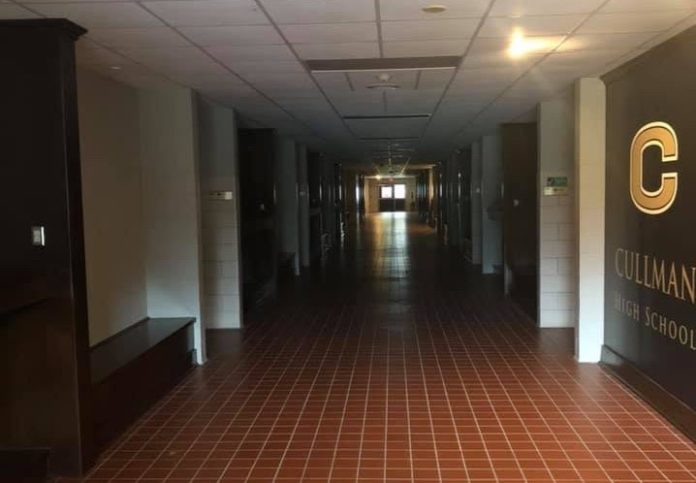
CULLMAN COUNTY, Ala. – On Mar. 30, the Alabama State Board of Education is set to release instructions about the schedule for the remainder of the semester, particularly the possibility of a return to school on Apr. 6. In the meantime, considering the very real possibility of extended school closures, teachers and administrators around Cullman are using online resources to stay connected to students and provide a little normalcy through continuing instructional curriculum.
Cullman High School Principal Kim Hall
Hall told The Tribune that teachers are utilizing and expanding online resources already in use by the system.
“As far as the high school, all of our students have Chromebook devices, and our teachers have what’s called Learning Management System. And they can use that through Google Classroom, Edmodo; they can use Canvas, they can use Schoology. Or our math teachers already use MathXL,” Hall said. “So, we already have all of that in place that we were using. Even with our live instruction, teachers could upload their PowerPoint presentations, they could upload assignments, they could have discussion boards on those programs. So those things, for us, were already in place. Before we left, we went ahead and communicated that we would be providing online lessons during this time, because we wanted to make sure that we were working through the kinks, and that we had a plan in place just as things progressed through this, so that’s one stable force in the lives of our students.”
Hall continued,
“The other thing is we wanted to make sure we were, as much as possible, staying in communication with our students. And you know, it’s difficult right now, because everyone is isolated and separated, but we know how important that communication is between a teacher and their students. So, we wanted to make sure that we had a way to keep up with them.”
“We did a survey prior to getting out of school, to find out which students did not have internet access at home, or wifi access that they could reach some way. And based on that survey, we have a partnership with a company called Leanstream for T-Mobile hot spots. That company worked with us to send us hot spots that we needed for our middle school and high school students. We were able to distribute those over the past week to anyone who didn’t have internet access. So that way, we know we’ve provided the internet access, if they needed it. We’ve provided the Chromebook for every student. And we have the Learning Management System in place.”
“Zoom”-ing ahead
Hall touched on another online tool some of the instructors have been taking advantage of as well.
“Now, one thing that we’re really trying out right now- and I think it’s all over the country- is an online program called Zoom. And some of our teachers were already using Zoom for online meetings, but what we’re doing right now is, we’re having small group meetings with teachers as departments, so that our teachers can see what the Zoom meetings are like, so that I can work with them on that and they can help each other. So, right now, we’re just doing trial runs with Zoom meetings. Some of our teachers are already doing Zoom meetings with their students, and they can meet with them face to face. They can share their screen access, so if they have a presentation or a test, or notes, or anything like that, they can show that to their students.”
“The other great thing about this is that they can record the lesson and they can do this through Google Hangouts. There are other programs too but when they have the class meeting or the tutorial, they can record the lesson, so that if we have teenagers who are having to help with younger siblings or they’re having to work. We’re hearing from a lot of them that work fast food that they’re really having to work extended hours right now so they can access the recorded lesson at a later time that works better for them.”
“Some resemblance of normalcy”
Hall shared, “Obviously, I don’t believe anything can replace the face-to-face instruction provided by a highly qualified teacher. And these circumstances are just forcing us to try to come up with ways that we can imitate that as much as possible. So, I definitely believe face-to-face instruction with a highly qualified teacher is irreplaceable, and I think parents are feeling this, right now, and students are feeling this and they’re missing their teachers.”
“I’ve received several emails from parents who were very thankful for the assignments that our teachers have provided. They’ve said that, even in these trying times, it’s provided some resemblance of normalcy and stability and structure in their lives. And so, I have received a lot of positive response from parents about how appreciative they were. Even though it’s hard- it’s very difficult- they want their children to learn. They have high expectations and high hopes for their children, and so they’re just really thankful.”
Need help with your tech?
Students or parents having technology issues can ask for assistance from the school’s tech department by emailing help@cullmancats.net. Through this account, the department will advise on software or connectivity problems, and set up times to bring in hardware for needed repairs.
Cullman City Primary School Principal Tricia Culpepper
Cullman Primary Principal Tricia Culpepper, who also heads up the system’s Head Start program, told The Tribune, “We went ahead at the Primary School and had our leadership committee meeting on that Friday before the Monday we were closed, just in case this might happen. I have three representatives from each pod. I have 26 kindergarten and first grade classrooms. So, my leadership committee consists of six grade level teachers, resource teacher, my media specialist, and we decided who was going to be handling the communication via Facebook and Twitter, and that was going to be my media specialist Hilary Nix.”
“We decided what platforms our teachers are going to use. And teachers like to use different platforms. So, I have some teachers doing ClassDojo, which is an app. I have some teachers that have their own YouTube channels, and some teachers are using the Remind app in order to give instruction to their students.”
“So, we also met with our resource teachers, and those are the teachers that work with our special needs students, and we came up for a plan for our special needs students, because we want to make sure to include everybody at the Primary School during this time.”
“Yesterday, I asked PTO if they would help me if I needed to have additional Chromebooks sent out for any student. So, I asked my teachers to reach out to their parents and see who needed a device. So, we’re working on that today. We’re getting our devices set up, and we’re going to have a meeting time when parents can come and get a device if they need one.”
The school is drawing up a loan contract for the parents who are taking Chromebooks.
Creative approaches
Culpepper added, “We’re doing different videos. We do a lot of communication for our community resources through- a lot goes through our CCPS PTO page. We’re doing different video readings and sharing those, I’m doing a “Mrs. Culpepper’s Neighborhood.” I did a social distancing story, and then I’m going to do another story today about washing your hands and exactly what the Coronavirus is, in kindergarten and first grade terms for them.”
“I met with my leadership team today, and we discussed a plan of action if we have teachers that get sick, and how we’re going to cover those classes, as far as lessons go. So, we have that worked out. And then also, if a parent or a caretaker gets ill and somebody needs to access our resources, we also have a plan of action; we’re going to post information on our website.”
“I plan on having a wellness Wednesday for faculty and staff where I share an uplifting podcast or devotional, or workout for our students. We even have our PE teacher posting videos. And our art teacher, she has her own YouTube channel, and she’s doing art lessons.”
“So, I am just so proud of our teachers and staff. They have worked so hard to make sure that they communicate with parents and see anything that we can do for our students during this time. We want to make sure that we can provide the instruction that our students need, so that they can be successful.”
“We also want to reach out to our families, because we know that we’ve got families that will have nurses and doctors, and other medical staff that are working really hard. So we don’t want to put any undue pressure on them, and we don’t want to make it a requirement to complete the work, but we want to have the resources available when they are able to complete the work.”
Head Start
Culpepper told The Tribune, “At the Primary School we also service our Head Start, which is our most vulnerable population. We have five Head Start classes: two three-year-old classes and three four-year-old classes. We’re doing a lot of meetings through Zoom, and so I just finished a meeting with them, and we have a course of action for them, too, and we’re sharing things through Facebook. It’s very similar to what the Primary side is doing.”
Elementary schools
In a message to The Tribune, East Elementary Principal David Wiggins described what the elementary schools have been doing.
“We have reading and math assignments that are posted on our website. We wanted to review prior taught concepts in these two weeks leading up to Spring Break. Our students can login with Clever badges and Google accounts to access websites with educational content. Our 6th grade teachers have their assignments on Google Classroom for our students. We, our students, have Edgenuity accounts through Odyssey Learning that allow students to work on skills that were weaker skills on their last Scantron Performance tests.”
“(West Elementary Principal) Jay (Page) and I planned the same for each school. In addition, some teachers are promoting reading, ELA, and Math challenges to their class.”
County system plagued by lack of internet access in remote areas
The county system does not have an organized curriculum plan underway yet and, according to County School Superintendent Dr. Shane Barnette, a major problem hindering the county system from developing and implementing such a plan is the large number of students across the county who lack internet access.
Barnette told The Tribune, “We have such a problem with connectivity out in our district. I’ve tried to do as much as I can: we’ve offered hot spots to every student from seventh grade up, I think it is, and I shared out a link with Spectrum- they’ll give them free 60 days of internet, if they have access to it, and things like that. But it’s still spotty, at best.”
The system uses hot spot devices from T-Mobile. Users have reported issues with internet connections through the devices, especially in outlying spots like Holly Pond and Vinemont. The city system, also using T-Mobile hot spots but in an urban setting with fairly consistent good cell service, is not reporting connectivity issues.
Barnette said of his instructors, “They’ve shared a lot of books and they’ve shared a lot of links for people that have internet, but I don’t think, right now, there’s a whole lot of going back and forth between teacher and student. But that could definitely change after spring break, depending on what direction we go as a state.
“All of the superintendents completed a survey of what we’d like to see done. I even shared in that survey our struggle: if we had some schooling online, there’d be a lot of our students that wouldn’t have access. So, I don’t really know what we’d do.”
Copyright 2020 Humble Roots, LLC. All Rights Reserved.






























